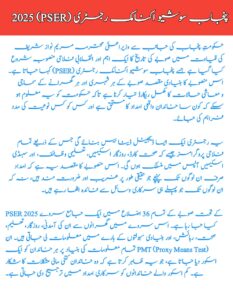The Government of Punjab has officially launched a transformative welfare initiative — the Punjab Socio-Economic Registry (PSER), also called the Social Protection Registry. Introduced under the leadership of Chief Minister Maryam Nawaz Sharif, this project aims to collect and maintain an up-to-date database of every household’s socio-economic status across Punjab.
The PSER is not just a data collection project — it is a revolutionary step toward digital governance, targeted social protection, and poverty reduction. Through this registry, the Punjab government seeks to ensure that every eligible family receives fair access to financial assistance, healthcare, education, housing, and energy subsidies.
This article provides the complete details of the PSER program — its purpose, objectives, eligibility, registration process, benefits, and everything you need to know to get registered in 2025.
Background of the PSER Program
Before PSER, Punjab lacked a centralized system to identify who truly qualified for welfare benefits. Many social programs overlapped, and several deserving families were left out simply because there was no verified provincial database.
Recognizing this gap, CM Maryam Nawaz launched the Punjab Socio-Economic Registry in mid-2024. The project aims to compile accurate, verifiable information about households’ economic conditions, so future welfare schemes can be efficiently targeted.
This initiative follows the model of the Benazir Income Support Program (BISP) at the federal level, but PSER is specifically designed for Punjab’s local context — focusing on education, health, employment, and energy inclusion.
Objectives of the PSER Program
The main goals of the Punjab Socio-Economic Registry are as follows:
- Identify deserving families:
Establish a transparent and data-driven mechanism to recognize households that genuinely need assistance. - Reduce duplication and fraud:
Prevent multiple benefits from being claimed by the same individuals or ineligible families. - Create a unified database:
Maintain a single registry for all Punjab government welfare schemes to ensure coordination and efficiency. - Enable targeted aid:
Use data to deliver resources directly to the poor and vulnerable segments. - Support digital inclusion:
Make all registration and verification processes accessible online, allowing citizens to manage their profiles digitally. - Improve policy formulation:
Help the government design effective, evidence-based policies for poverty alleviation and social welfare.
Scope and Coverage
The PSER is a province-wide program covering all 36 districts of Punjab. It includes:
- Employment and assets
- Health and education levels
- Type of housing and facilities
- Utility access (electricity, water, gas, internet)
- Disabilities or chronic illnesses
This broad coverage helps the government build a multi-dimensional poverty profile for every family.
Eligibility Criteria
To register for PSER 2025, households must meet certain conditions:
- Permanent residence in Punjab
Only families living within the province are eligible. - Valid identification documents
CNIC for adults and B-Form for children are required. - Low or moderate income level
Families struggling to meet basic needs will be prioritized. - Willingness to provide accurate data
False information can lead to disqualification. - One registration per household
Duplicate or multiple entries are not allowed.
Registration does not automatically guarantee financial aid — it only qualifies a family to be considered for future government programs based on their PMT (Proxy Means Test) score.
How to Register for PSER 2025
There are two primary ways to register in the Punjab Socio-Economic Registry: Online Registration and In-Person Registration.
1. Online Registration Method
The easiest way to register is through the official portal:
👉 https://pser.punjab.gov.pk
Follow these steps:
- Visit the official website – Open the PSER portal.
- Create an account – Enter your CNIC, mobile number, and password.
- Log in and start registration – Click “New Application.”
- Fill in personal details:
- Head of family name and CNIC
- Gender, date of birth, marital status
- Address and contact information
- Add family members – Include all dependents, children, and the elderly.
- Provide income and employment details – Salary, business, or agricultural income.
- Enter housing and utility information – Type of house, number of rooms, access to water and electricity.
- Attach supporting documents – CNIC scans, utility bills, etc.
- Submit the form – Review everything before submitting.
- Get acknowledgment – A reference number or registration ID will be issued.
You can later use this ID to check your registration or PMT score updates.
2. Registration through PSER Centers
For citizens without internet access, Punjab has set up over 5,000 registration centers across the province. You can visit your Union Council, Tehsil Office, or Local Facilitation Center to register in person.
At these centers:
- Officials will help you fill out your form.
- Biometric verification may be done on-site.
- After completion, you’ll receive a registration slip or tracking ID.
- A verification team may visit your home later for confirmation.
Verification Process
After registration, each household’s data goes through several verification stages:
- Field Verification:
Teams visit homes to confirm information like housing type, assets, and family composition. - Data Cross-Checking:
Information is compared with NADRA, FBR, and utility databases to ensure accuracy. - PMT Scoring:
A numerical score is calculated based on income, assets, and living standards. This determines eligibility for future benefits. - Database Entry:
Once verified, your household becomes part of the official PSER database.
Benefits of PSER Registration
Being part of the Punjab Socio-Economic Registry opens doors to multiple welfare programs and subsidies. Here are the main benefits:
| Program | Description |
|---|---|
| Health Card Program | Free or subsidized treatment at public and private hospitals. |
| E-Bike Scheme | Subsidized electric motorbikes for students and workers. |
| Roshan Gharana Program | Solar panel subsidies for low-income households. |
| Kissan Card | Access to agricultural loans and fertilizer subsidies for farmers. |
| Himmat Card | Direct cash assistance for extremely poor families. |
| Education Scholarships | Financial support for students from registered families. |
| Livestock Support Program | Aid for rural households owning cattle or poultry. |
| Future Subsidy Programs | Any new provincial welfare schemes will be linked with PSER. |
In short, if you’re not registered, you may not be eligible for upcoming Punjab government benefits.
PSER PMT Score – What It Means
The Proxy Means Test (PMT) score is the ranking system used to determine who qualifies for aid.
It measures economic status based on various indicators, including:
- Family income and expenditure
- Household size
- Type of housing
- Ownership of assets or vehicles
- Utility access
- Education and employment status
Lower PMT scores indicate higher poverty levels, meaning those families are given priority in social protection schemes.
Data Privacy and Security
The unjab government has ensured that all data collected under PSER is stored in encrypted digital databases. Only authorized personnel can access household information.
Strict data protection protocols have been introduced to safeguard citizen privacy. Households are encouraged to share truthful information without fear of misuse.
Challenges and Future Plans
While PSER is a groundbreaking initiative, it also faces certain challenges:
Key Challenges
- Difficulty in reaching remote rural areas.
- Risk of false data submission.
- Need for continuous data updates.
- Ensuring transparency in verification.
- Public awareness and trust building.
Government Response
- Launch of awareness campaigns in all districts.
- Deployment of mobile registration units.
- Integration with NADRA for real-time verification.
- Helpline for complaints and corrections.
- Regular re-verification cycles to keep data current.
PSER Helpline and Support
If you need help with registration or verification, contact:
📞 Helpline: 0800-02345
🌐 Official Portal: https://pser.punjab.gov.pk
🏢 Visit: Your nearest PSER or Union Council center.
Frequently Asked Questions (FAQs)
Q1: What is PSER?
PSER stands for Punjab Socio-Economic Registry — a system for registering all households to identify those eligible for welfare support.
Q2: Is PSER registration free?
Yes, registration is completely free of cost. No official or agent can charge you.
Q4: What documents are needed?
CNIC/B-Form, address proof, and basic household information.
Q5: When will the door-to-door survey start?
The government has announced that the large-scale survey will begin in 2025 across all districts.
Q6: How will I know my PMT score?
You can check updates on the portal or receive an SMS notification once your data is processed.
Q7: What if my income changes after registration?
You must update your information at your nearest center or through the online portal.
Q8: Does registration guarantee cash support?
No — it qualifies you for consideration, but the benefit depends on your PMT score and eligibility criteria.
Impact of the PSER Program
The PSER will have far-reaching effects on governance and poverty management in Punjab:
- Transparent distribution of government aid
- Elimination of middlemen and favoritism
- Accurate poverty mapping for better policymaking
- Empowerment of women and rural families
- Integration of data for digital governance
Experts believe this initiative could become a national model for social protection, much like NADRA’s CNIC database revolutionized identification.
Conclusion
The Punjab Socio-Economic Registry (PSER) is one of the most important welfare initiatives in the province’s history. By accurately identifying deserving households, the Punjab government is taking a major step toward ending poverty, improving transparency, and ensuring inclusive growth.
For More Information Click Here

